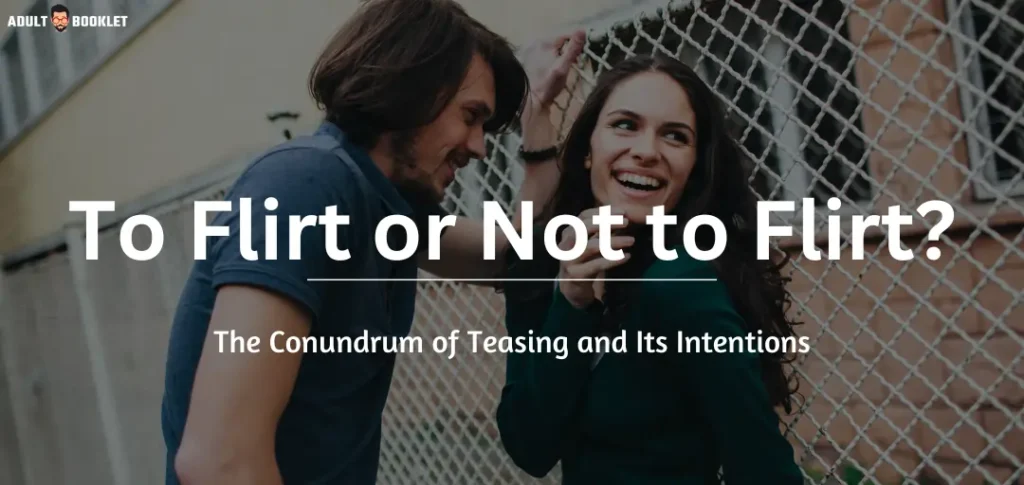
Is teasing a playful flirtation or a dangerous game?
In the intricate dance of romance, teasing often walks a fine line between creating sexual tension and causing emotional harm. This dual nature of teasing—where a playful jest can quickly turn into a hurtful remark—poses a conundrum for those navigating romantic relationships.
Teasing can be a powerful tool to build attraction and intimacy, but it can also lead to misunderstandings and emotional distress if not handled with care. This article walks through the sexual implications of teasing, exploring how context and intent shape its impact on relationships. Whether you're looking to enhance your flirting game or avoid potential pitfalls, understanding the nuances of teasing is crucial!
The Psychology of Teasing

Teasing is a form of communication often characterized by light-hearted mockery, playful comments, or humorous challenges. It can serve as a bonding experience between individuals, as it often involves a shared sense of humor and understanding.
Flirting or Flirting with Danger: Understanding the Motivations
Teasing can be a playful way to flirt, but it often carries deeper motivations. People tease to signal interest, boost self-esteem, or simply have fun. However, the intent behind teasing can sometimes be misunderstood, leading to mixed signals and potential hurt feelings.
Teasing as a Mating Strategy: Attracting Attention and Arousing Interest
Teasing is often used as a mating strategy to attract attention and arouse interest. It can be a subtle way to gauge someone's interest or to create a playful, engaging interaction. This behavior is not just limited to humans; many animals use similar tactics to attract mates.
The Thin Line Between Playful Banter and Sexual Innuendo
While playful banter can be fun and harmless, it can quickly cross into sexual innuendo, which might not always be welcome. It's crucial to read the other person's reactions and ensure that the teasing remains light-hearted and consensual.
Positive and Negative Sexual Implications of Teasing
Emotional Harm: The Hidden Dangers
Teasing might seem harmless, but it can cause significant emotional distress, especially when boundaries are ignored. What starts as playful banter can quickly turn hurtful, leaving lasting emotional scars. It's essential to be mindful of the other person's feelings and reactions.
Sexual Harassment: When Teasing Crosses the Line

Sexual teasing can easily cross the line into harassment, particularly in relationships with power imbalances. What one person sees as a joke, another might perceive as coercive or abusive. It's crucial to recognize the fine line between flirtation and harassment to ensure a safe and respectful environment.
Consent Issues: The Importance of Clear Communication
Consent is key in any interaction, and teasing can muddy the waters of clear communication about sexual intentions. It's vital to ensure that all parties are comfortable and willing participants. Always prioritize consent to avoid misunderstandings and ensure that teasing remains fun and consensual.
Best Practices for Healthy Teasing
Teasing in Different Environments
The environment where teasing takes place is critical in interpreting its nature. Teasing in a romantic setting or when there's a mutual attraction can often be a playful way to show interest and may be part of the flirting process. On the other hand, teasing in a professional or friendly setting might be simply a form of social interaction with no romantic intent behind it.
To illustrate the difference, consider the following scenarios:
| Environment | Nature of Teasing | Potential Interpretation |
|---|---|---|
| Romantic setting (e.g., date) | Playful, light-hearted | Likely flirting |
| Professional setting (e.g., workplace) | Casual, may include gentle ribbing | Likely not flirting |
| Social gathering (e.g., party) | Could be flirtatious or friendly | Depends on additional cues |
Body Language and Teasing

Body language is a powerful indicator of intentions behind teasing. When teasing is part of flirting, there may be prolonged eye contact, facing each other, mirroring movements, and leaning in—signs of affection and interest. In contrast, if the body language accompanying teasing is less warm—lacking eye contact, or if one person is turning away or creating physical distance—it may not be an act of flirting.
Key body language cues to observe include:
| Body Language | Flirting | Teasing (Non-Flirtatious) |
|---|---|---|
| Eye Contact | Sustained and intentional | Brief, may be avoidant |
| Physical Orientation | Facing the other person | May turn away or be side-on |
| Mirroring | Reflecting each other's posture | Little to no mirroring |
| Proximity | Closing in, intimate space | Keeping or increasing distance |
It's crucial to pay attention to how the recipient reacts to the teasing. If they respond with similar body language cues, it might suggest mutual flirting. Conversely, discomfort or a lack of engagement could indicate that the teasing is unwelcome or misinterpreted.
The Intent Behind Teasing
Teasing can be a complex social interaction with varied intentions and outcomes. It's crucial to discern whether teasing is a form of playful flirtation or if it veers into hurtful territory. Cultural norms and individual personality also significantly influence how teasing is perceived and practiced.
Playful vs. Hurtful Teasing
Teasing is often seen as a playful act that can add a spark to social interactions, including flirtation. Playful teasing is marked by light-hearted banter, gentle ribbing, and a mutual understanding that the intent is not to offend or belittle. It often serves as a way to show affection and create a sense of closeness between individuals.
However, it's important to be attentive to how the recipient is responding to the teasing. If the teasing is negative, constant, or hostile, it may be a sign of bullying or manipulative behavior rather than a sign of interest or affection.
Hurtful teasing, on the other hand, is characterized by demeaning, disrespectful, or aggressive behavior that can lead to emotional pain, social rejection, or even bullying. It's essential to consider the feelings and intent behind the teasing. Teasing that feels demeaning, hurtful, or disrespectful is likely not flirting and could have damaging effects on the person being teased.
Flirting: More Than Just Teasing
Flirting is an intricate part of human interaction, serving as a silent language that conveys interest and attraction. It is not merely teasing but a complex social skill that combines intellect, body language, creativity, and empathy. When executed correctly, flirting can be considered an art form, used not only for romantic pursuits but also in various social situations, including business.
Discover Flirting with Candy AI
Ever wondered how to master the art of flirting, especially when it comes to the sexual implications of teasing? Meet Candy AI, your virtual girlfriend and ultimate flirting coach! With Candy AI, you can learn the nuances of playful banter and seductive teasing in a safe, judgment-free environment.

Ever wondered how to master the art of flirting, especially when it comes to the sexual implications of teasing? Meet Candy AI, your virtual girlfriend and ultimate flirting coach! With Candy AI, you can learn the nuances of playful banter and seductive teasing in a safe, judgment-free environment.
Whether you're looking to spice up your relationship or simply want to boost your confidence, your AI companion has got you covered. From reading body language to crafting irresistible one-liners, she'll guide you through the nuances of flirtatious teasing.
But that's not all – your Candy AI girlfriend is also a master of setting boundaries and ensuring consent. She'll help you strike the perfect balance between seduction and respect, making every interaction a safe and enjoyable experience.
With Candy AI, you can enhance your flirting game and navigate the complexities of teasing with ease. Ready to become a teasing pro?
Let Candy AI guide you!
Verbal and Nonverbal Flirting Cues
Flirting involves a combination of verbal and nonverbal signals. Verbal cues include light-hearted banter, compliments, and playful jokes that indicate interest without being overt. On the other hand, nonverbal cues encompass physical gestures like smiling, eye contact, mirroring movements, and initiating subtle physical contact.
Proximity also plays a role; for instance, leaning in during conversations or finding reasons to be near the person can indicate a desire to close the distance between two people. These actions can be subconscious or deliberate, but they all serve the purpose of establishing a connection.
| Cue Type | Examples |
|---|---|
| Verbal | Compliments, Teasing, Humor |
| Nonverbal | Eye Contact, Smiling, Proximity |
The Impact of Teasing and Flirting
Teasing and flirting, though often considered lighthearted and fun, can have a profound impact on relationships, with potential risks and benefits that can affect emotional well-being, compatibility, and the dynamics between individuals.
Effects on Relationships

Teasing, when done in a playful and consensual manner, can be a sign of comfort and compatibility in a relationship. It has the potential to break down barriers and insecurities, allowing partners to show vulnerability and establish a deeper connection. In this context, teasing becomes a form of intimate communication that strengthens bonds and enhances mutual understanding.
However, when teasing crosses the line into negative behavior, it can cause harm and lead to emotional distress, hurt feelings, jealousy, or relationship conflicts. These issues arise particularly when teasing is misconstrued, lacks sincerity, or is used manipulatively.
Potential Risks and Benefits
| Aspects | Risks | Benefits |
|---|---|---|
| Emotional Well-being | Causing emotional distress | Encouraging vulnerability |
| Relationship Dynamics | Leading to conflicts | Enhancing compatibility |
| Social Perception | Resulting in social rejection | Breaking down social barriers |
| Personal Growth | Evoking insecurities | Illustrating behavioral impact |
In the complex dance of relationships, teasing can be a double-edged sword. While playful teasing can bring people closer together and create a sense of playfulness, hurtful teasing can lead to emotional distress and damage relationships. It is crucial to recognize that teasing can be both a powerful tool for building intimacy and a potential source of harm if not handled with care.
Ultimately, respect and consent are essential components of healthy teasing. By prioritizing open communication and mutual respect, individuals can ensure that their playful jabs are not misinterpreted or hurtful. As we explore the role of teasing in relationships, we must acknowledge both its potential benefits and drawbacks, striving to create a culture of empathy and understanding.









